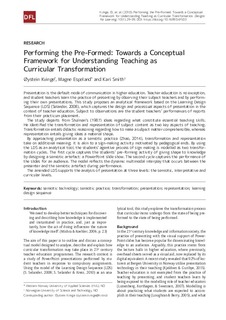| dc.contributor.author | Kvinge, Øystein Røsseland | |
| dc.contributor.author | Espeland, Magne | |
| dc.contributor.author | Smith, Kari | |
| dc.date.accessioned | 2018-10-17T12:57:35Z | |
| dc.date.available | 2018-10-17T12:57:35Z | |
| dc.date.created | 2018-04-19T13:33:41Z | |
| dc.date.issued | 2018 | |
| dc.identifier.issn | 1654-7608 | |
| dc.identifier.uri | http://hdl.handle.net/11250/2568510 | |
| dc.description.abstract | Presentation is the default mode of communication in higher education. Teacher education is no exception, and student teachers learn the practice of presenting by observing their subject teachers and by performing their own presentations. This study proposes an analytical framework based on the Learning Design Sequence (LDS) (Selander, 2008), which captures the design and processual aspects of presentation in the context of teacher education. Subject to observations are the student teachers’ performances of reports from their practicum placement.
The study departs from Shulman’s (1987) ideas regarding what constitute essential teaching skills. He identified the transformation and representation of subject content as two key aspects of teaching. Transformation entails didactic reasoning regarding how to make a subject matter comprehensible, whereas representation entails giving ideas a material shape.
By approaching presentation as a semiotic practice (Zhao, 2014), transformation and representation take on additional meaning; it is akin to a sign-making activity motivated by pedagogical ends. By using the LDS as an analytical tool, the students’ agentive process of sign making is modelled as two transformation cycles. The first cycle captures the students’ pre-forming activity of giving shape to knowledge by designing a semiotic artefact: a PowerPoint slide show. The second cycle captures the performance of the slides for an audience. The model reflects the dynamic multimodal interplay that occurs between the presenter and the semiotic artefact during performance.
The amended LDS supports the analysis of presentation at three levels: the semiotic, interpretative and curricular levels. | nb_NO |
| dc.language.iso | eng | nb_NO |
| dc.publisher | Stockholm University Press | nb_NO |
| dc.rights | Navngivelse 4.0 Internasjonal | * |
| dc.rights.uri | http://creativecommons.org/licenses/by/4.0/deed.no | * |
| dc.subject | Sosialsemiotikk | nb_NO |
| dc.subject | Social semiotics | nb_NO |
| dc.subject | Multimodalitet | nb_NO |
| dc.subject | Multimodality | nb_NO |
| dc.title | Performing the pre-formed: Towards a conceptual framework for understanding teaching as curricular transformation | nb_NO |
| dc.title.alternative | Performing the pre-formed: Towards a conceptual framework for understanding teaching as curricular transformation | nb_NO |
| dc.type | Journal article | nb_NO |
| dc.type | Peer reviewed | nb_NO |
| dc.description.version | publishedVersion | nb_NO |
| dc.subject.nsi | VDP::Pedagogiske fag: 280 | nb_NO |
| dc.subject.nsi | VDP::Education: 280 | nb_NO |
| dc.source.journal | Designs for Learning | nb_NO |
| dc.identifier.doi | 10.16993/dfl.83 | |
| dc.identifier.cristin | 1580385 | |
| dc.description.localcode | © 2018 The Author(s). This is an open-access article distributed under the terms of the Creative Commons Attribution 4.0 International License (CC-BY 4.0), which permits unrestricted use, distribution, and reproduction in any medium, provided the original author and source are credited. See http://creativecommons.org/licenses/by/4.0/. | nb_NO |
| cristin.unitcode | 194,0,0,0 | |
| cristin.unitname | Norges teknisk-naturvitenskapelige universitet | |
| cristin.ispublished | false | |
| cristin.fulltext | original | |
| cristin.qualitycode | 1 | |

